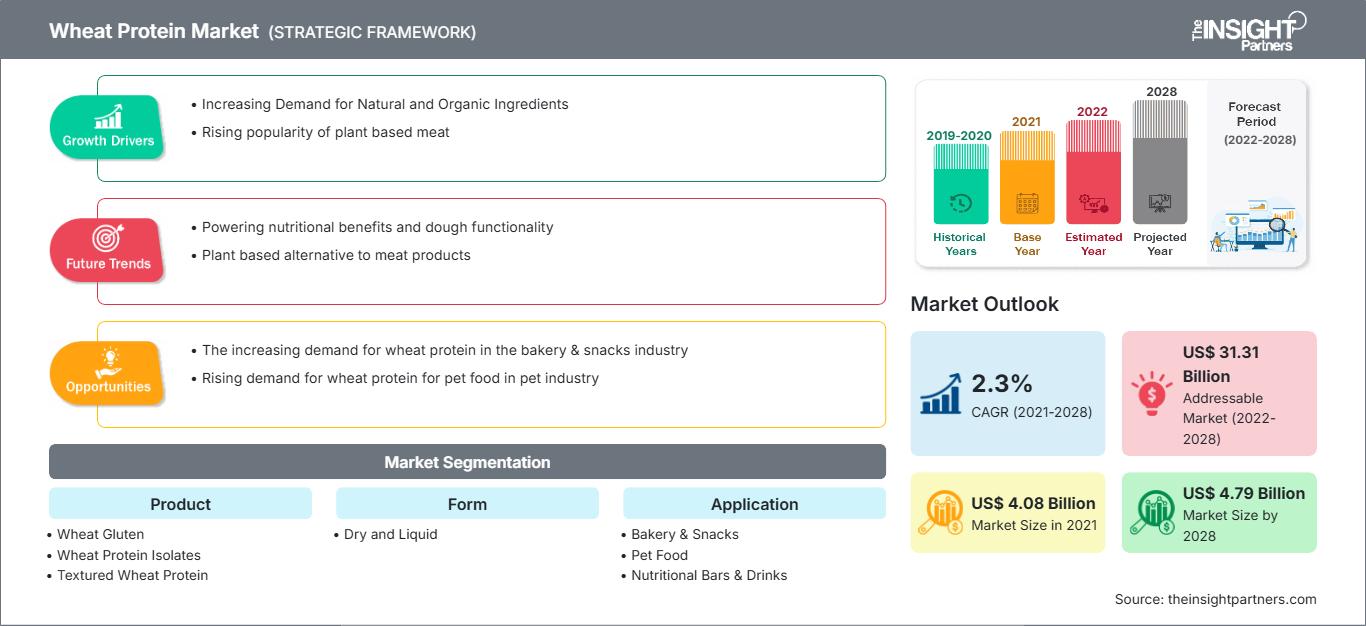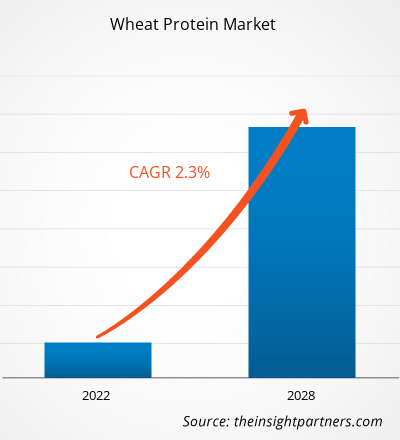[Forschungsbericht]Der Markt für Weizenproteine wurde im Jahr 2021 auf 4.083,05 Millionen US-Dollar geschätzt und soll bis 2028 4.788,49 Millionen US-Dollar erreichen; von 2021 bis 2028 wird ein CAGR-Wachstum von 2,3 % erwartet.
Weizenproteine sind pflanzliche Proteine, die hauptsächlich durch die Verarbeitung von Weizen mit verschiedenen Enzymen gewonnen werden. Es handelt sich um unlösliche funktionelle Proteine mit einzigartigen viskoelastischen Eigenschaften, die dem Endprodukt Elastizität und Dehnbarkeit verleihen. Die Proteine gelten als praktikable Alternative zu tierischen Proteinen. Sie finden breite Anwendung in verschiedenen Endverbrauchsbranchen, wie z. B. Bäckereien und Süßwaren, Kosmetik und Körperpflege, Tierfutter und Nahrungsergänzungsmitteln.
Im Jahr 2020 hatte Europa den größten Umsatzanteil am globalen Weizenproteinmarkt. Der europäische Markt ist in Deutschland, Frankreich, Italien, Großbritannien, Russland und das übrige Europa unterteilt. Das steigende Gesundheitsbewusstsein der Verbraucher treibt die Nachfrage nach zahlreichen pflanzlichen Proteinprodukten wie Soja, Weizen und Hafer an. Die Beliebtheit von Weizenprotein hat in der gesamten Region zugenommen, insbesondere in Deutschland, Frankreich und Großbritannien. Europäer ernähren sich zunehmend flexitarisch, d. h. sie ersetzen einen Teil oder den größten Teil ihres Fleischkonsums durch alternative Proteinnahrungsmittel. Diese Faktoren treiben die Nachfrage nach Weizenproteinprodukten in Europa an.
Passen Sie diesen Bericht Ihren Anforderungen an
Sie erhalten kostenlos Anpassungen an jedem Bericht, einschließlich Teilen dieses Berichts oder einer Analyse auf Länderebene, eines Excel-Datenpakets sowie tolle Angebote und Rabatte für Start-ups und Universitäten.
Weizenproteinmarkt: Strategische Einblicke

-
Holen Sie sich die wichtigsten Markttrends aus diesem Bericht.Dieses KOSTENLOSE Beispiel umfasst Datenanalysen, die von Markttrends bis hin zu Schätzungen und Prognosen reichen.
Viele Branchen, wie beispielsweise die Lebensmittel- und Getränkeindustrie, standen aufgrund der COVID-19-Pandemie vor beispiellosen Herausforderungen. Aufgrund von Rohstoffknappheit, Fabrikschließungen, Arbeitskräftemangel und anderen Schwierigkeiten im Betrieb gemäß den COVID-19-Sicherheitsprotokollen hatten Unternehmen, die Weizenprotein herstellen, in den ersten Monaten der Pandemie mit Schwierigkeiten zu kämpfen. Der Lebensmittel- und Getränkesektor ist der Hauptverbraucher von Weizenprotein und die anhaltende COVID-19-Pandemie hat die Nachfrage nach Weizenprotein negativ beeinflusst. Lebensmittel- und Getränkeprodukte wie Backwaren, Süßwaren und Milchprodukte geraten in den Hintergrund, da die Supermärkte aufgrund des Ausbruchs ihre Lagerbestände auf Grundnahrungsmittel und lebensnotwendige Güter umverteilt haben. Da die Volkswirtschaften jedoch wieder anlaufen, wird erwartet, dass die Nachfrage nach Weizenprotein in den kommenden Monaten weltweit stark ansteigen wird. Die COVID-19-Pandemie hat zu einer erhöhten Nachfrage nach gesunden und funktionellen Backwaren geführt, was das Wachstum des Weizenproteinmarktes in den kommenden Jahren voraussichtlich ankurbeln wird.
Markteinblicke
Steigende Nachfrage nach natürlichen und biologischen Zutaten
Die Bedeutung von Bio-Lebensmitteln wurde angesichts alarmierender Gesundheitsprobleme, des zunehmenden Bewusstseins für Bio-Zertifizierungen und der wachsenden Vorliebe für qualitativ hochwertige Lebensmittel erkannt. Heutzutage suchen Verbraucher nach natürlichen, sauberen und einfachen Zutaten mit entsprechenden Etiketten, die Inhalt, Qualität und Verwendungszweck des Produkts effektiv vermitteln können. Darüber hinaus sind sie weitgehend auf biologische und natürliche Lebensmittel angewiesen. Beispielsweise ist der Verbrauch von Bio-Weizenprotein in verschiedenen Anwendungsbereichen wie Lebensmitteln und Getränken sowie Tier- und Aquakulturfutter stark gestiegen. Daher konzentrieren sich die Hersteller von Weizenprotein auf die Entwicklung und Vermarktung von Bio-Weizenprotein.
Produktinformationen
Nach Produkten ist der globale Weizenproteinmarkt in Weizengluten, Weizenproteinisolate, texturiertes Weizenprotein und hydrolysiertes Weizenprotein unterteilt. Im Jahr 2020 machte das Weizenglutensegment den größten Umsatzanteil aus. Vitales Weizengluten wird als Backzusatz verwendet. Es verleiht Mehlen, die sonst wenig Gluten enthalten, wie z. B. Vollkornmehl oder Roggen, Elastizität. Weizengluten verbessert außerdem das Aufgehen des Rohteigs und verbessert die Textur und Bissfestigkeit des Endprodukts.
Forminformationen
Der Weizenproteinmarkt ist nach Form in Trocken- und Flüssigprotein unterteilt. Im Jahr 2020 machte das Trockensegment einen größeren Umsatzanteil aus. Zu den Eigenschaften von trockenem Weizenprotein gehören die hohe Wasserlöslichkeit bei jedem pH-Wert, die Fähigkeit zur Wasserbindung und -emulgierung, die niedrige Viskosität sowie die Säure- und Wärmestabilität. Trockenes Weizenprotein wird zunehmend in Backwaren, Tiernahrung, Nährstoffriegeln, verarbeitetem Fleisch und Fleischersatzprodukten verwendet. Somit fördern die vielfältigen Anwendungsmöglichkeiten in der Lebensmittelindustrie das Marktwachstum im Trockensegment.
Anwendungseinblicke
Der Weizenproteinmarkt ist nach Anwendung in Backwaren und Snacks, Tiernahrung, Nährstoffriegel und -getränke, verarbeitetes Fleisch, Fleischersatzprodukte und Sonstiges unterteilt. Im Jahr 2020 machte das Segment Backwaren und Snacks den größten Umsatzanteil aus. Zahlreiche Backwaren wie Brötchen, Brot, Kekse, Gebäck, Kuchen und Muffins erfreuen sich bei den Verbrauchern großer Beliebtheit. Weizenproteine gehören zu den gängigen Zutaten, die das Teigverhalten optimieren und die Nährwerte der Endprodukte verbessern. Die steigende Nachfrage nach Weizenprotein in der Back- und Snackbranche Die Snackbranche und der Clean-Label-Trend schaffen zahlreiche Chancen für die Akteure auf dem weltweiten Weizenproteinmarkt.
Archer Daniels Midland Company; Roquette Frères; Glico Nutrition Co., Ltd; Kröner-Stärke GmbH; Cargill, Incorporated; Crespel & Deiters GmbH & Co. KG; CropEnergies AG; Manildra Group; MGP Ingredients Inc.; und Tereos Group sind einige der etablierten Akteure auf dem globalen Weizenproteinmarkt. Die Unternehmen auf dem Markt verfolgen verschiedene Strategien wie Produktentwicklungen, Werkserweiterungen sowie Fusionen und Übernahmen, um ihre Präsenz weltweit auszubauen und die wachsende Nachfrage der Endverbraucher zu befriedigen. So hat beispielsweise die Archer Daniels Midland Company im Jahr 2020 neue Produkte entwickelt. Die Produkte enthalten Arcon T texturierte Erbsenproteine, Prolite MeatTEX texturiertes Weizenprotein und Prolite MeatXT nicht texturiertes Weizenprotein.
Berichts-Spotlights
- Progressive Branchentrends auf dem globalen Weizenproteinmarkt, um Akteuren bei der Entwicklung effektiver langfristiger Strategien zu helfen
- Geschäftswachstumsstrategien in entwickelten und sich entwickelnden Märkten
- Quantitative Analyse des globalen Weizenproteinmarktes von 2019 bis 2028
- Schätzung der Nachfrage nach Weizenprotein in verschiedenen Branchen
- Jüngste Entwicklungen zum Verständnis des Wettbewerbsmarktszenarios und der Nachfrage nach Weizenprotein
- Markttrends und -aussichten in Verbindung mit Faktoren, die das Wachstum des Weizenproteinmarktes vorantreiben und hemmen
- Entscheidungsprozess durch das Verständnis von Strategien, die das kommerzielle Interesse im Hinblick auf das Wachstum des globalen Weizenproteinmarktes untermauern
- Größe des Weizenproteinmarktes an verschiedenen Knotenpunkten des Marktes
- Detaillierter Überblick und Segmentierung des globalen Weizenproteinmarktes sowie seiner Dynamik in der Branche
- Weizenproteinmarktgröße in verschiedenen Regionen mit vielversprechenden Wachstumschancen
Weizenprotein
Regionale Einblicke in den WeizenproteinmarktDie Analysten von The Insight Partners haben die regionalen Trends und Faktoren, die den Weizenproteinmarkt im Prognosezeitraum beeinflussen, ausführlich erläutert. In diesem Abschnitt werden auch die Marktsegmente und die geografische Lage in Nordamerika, Europa, Asien-Pazifik, dem Nahen Osten und Afrika sowie Süd- und Mittelamerika erörtert.
Umfang des Weizenprotein-Marktberichts
| Berichtsattribut | Einzelheiten |
|---|---|
| Marktgröße in 2021 | US$ 4.08 Billion |
| Marktgröße nach 2028 | US$ 4.79 Billion |
| Globale CAGR (2021 - 2028) | 2.3% |
| Historische Daten | 2019-2020 |
| Prognosezeitraum | 2022-2028 |
| Abgedeckte Segmente |
By Produkt
|
| Abgedeckte Regionen und Länder |
Nordamerika
|
| Marktführer und wichtige Unternehmensprofile |
|
Dichte der Marktteilnehmer für Weizenproteine: Verständnis ihrer Auswirkungen auf die Geschäftsdynamik
Der Weizenproteinmarkt wächst rasant, angetrieben durch die steigende Endverbrauchernachfrage aufgrund von Faktoren wie sich entwickelnden Verbraucherpräferenzen, technologischem Fortschritt und einem stärkeren Bewusstsein für die Produktvorteile. Mit steigender Nachfrage erweitern Unternehmen ihr Angebot, entwickeln Innovationen, um den Verbraucherbedürfnissen gerecht zu werden, und nutzen neue Trends, was das Marktwachstum weiter ankurbelt.

- Holen Sie sich die Weizenproteinmarkt Übersicht der wichtigsten Akteure
Weizenprotein-Markt, nach
- Produkt
- Weizengluten
- Weizenprotein-Isolate
- Texturiertes Weizenprotein
- Hydrolysiertes Weizenprotein
Weizenprotein-Markt, nach Form
- Trocken
- Flüssig
Markt für Weizenprotein, nach Anwendung
- Bäckerei & Snacks
- Tiernahrung
- Nahrungsriegel & Getränke
- Verarbeitetes Fleisch
- Fleischanaloge
- Sonstige
Firmenprofile
- Archer Daniels Midland Company
- Roquette Frères
- Glico Nutrition Co.,Ltd
- Kröner-Stärke GmbH
- Cargill, Incorporated
- Crespel & Deiters GmbH & Co. KG
- CropEnergies AG
- Manildra Group
- MGP Ingredients Inc.
- Tereos Group
- Historische Analyse (2 Jahre), Basisjahr, Prognose (7 Jahre) mit CAGR
- PEST- und SWOT-Analyse
- Marktgröße Wert/Volumen – Global, Regional, Land
- Branchen- und Wettbewerbslandschaft
- Excel-Datensatz
Aktuelle Berichte
Erfahrungsberichte
Grund zum Kauf
- Fundierte Entscheidungsfindung
- Marktdynamik verstehen
- Wettbewerbsanalyse
- Kundeneinblicke
- Marktprognosen
- Risikominimierung
- Strategische Planung
- Investitionsbegründung
- Identifizierung neuer Märkte
- Verbesserung von Marketingstrategien
- Steigerung der Betriebseffizienz
- Anpassung an regulatorische Trends






















 Kostenlose Probe anfordern für - Weizenproteinmarkt
Kostenlose Probe anfordern für - Weizenproteinmarkt